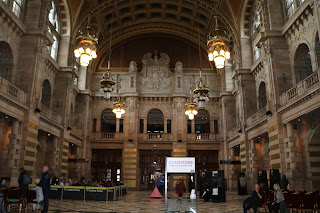Leaving the Highlands this morning, heading to Glasgow, which is the largest city in Scotland. Here are our driver, Neal (Left) and tour guide David at a stop.
Built on drumlins (small hills left by glaciers), Glasgow has had many ups and downs. (Haha) A guide named Alan joins us for commentary.
Founded as a monastery around 600 AD, it is connected to the coast by the River Clyde. It processed a great deal of sugar and tobacco from the "colonies" in the 1600's. It thrived as a major ship-building center in the late 1700's and early 1800's, as well as railroad and many other industries. Because of the industry it was hit hard during WWII and some areas not re-built. Today there is a little ship building and refurbishing, but it is more a hub for technology, particularly micro-satellites and is the main financial center for Scotland. It also is home to three universities. Population today is about 633,000, with a large well established ethnic population. Housing prices are about half of what they are in Edinburgh.

We visit the red-stoned Kelvingrove Art Gallery and Museum where we have tea- a light meal of lentil soup and an assortment of small sandwiches. Alan shows us some highlights of the museum including a huge organ, suits of armor and several paintings highlighting Scottish history. We are using the whisper headphones, so it is nice to be able to hear his descriptions.

The stained glass is more modern. The tomb of Saint Mungo is in the lower church.

Our hotel here is the Doubletree by Hilton and we finally have some heat in our room! We are on our own for dinner and Greg and I end up at an Indian Restaurant called Masala Twist where we enjoy Chicken Korma and Railroad Lamb Curry with a huge piece of nan. Very tasty! We again hear that the national dish of the United Kingdom is now curry.

























No comments:
Post a Comment